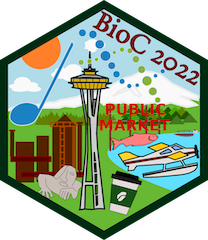This tutorial will showcase analysis of single-cell RNA sequencing data following the tidy data paradigm. The tidy data paradigm provides a standard way to organise data values within a dataset, where each variable is a column, each observation is a row, and data is manipulated using an easy-to-understand vocabulary. Most importantly, the data structure remains consistent across manipulation and analysis functions.
This can be achieved with the integration of packages present in the R CRAN and Bioconductor ecosystem, including tidySingleCellExperiment and tidyverse. These packages are part of the tidytranscriptomics suite that introduces a tidy approach to RNA sequencing data representation and analysis. For more information see the tidy transcriptomics blog.
- Basic familiarity with single-cell transcriptomic analyses
- Basic familiarity with tidyverse
- To approach single-cell data representation and analysis though a tidy data paradigm, integrating tidyverse with tidySingleCellExperiment.
- Compare SingleCellExperiment and tidy representation
- Apply tidy functions to SingleCellExperiment objects
- Reproduce a real-world case study that showcases the power of tidy single-cell methods
- Basic tidy operations possible with tidySingleCellExperiment
- The differences between SingleCellExperiment representation and tidy representation
- How to interface SingleCellExperiment with tidy manipulation and visualisation
- A real-world case study that will showcase the power of tidy single-cell methods compared with base/ad-hoc methods
- The molecular technology of single-cell sequencing
- The fundamentals of single-cell data analysis
- The fundamentals of tidy data analysis
The workshop format is a 1.5 hour session consisting of hands-on demos, exercises and Q&A.
Material web page. More details on the workshop are below.
For the BioC2022 workshop, an RStudio in the cloud will be provided with everything installed, all that participants will need is a web browser.
If you want to install the packages and material post-workshop, they can be installed using one of the two ways below. The workshop is designed for R 4.2 and Bioconductor 3.16.
If you're familiar with Docker you could use the Docker image which has all the software pre-configured to the correct versions.
docker run -e PASSWORD=abc -p 8787:8787 ghcr.io/tidytranscriptomics-workshops/bioc2022_tidytranscriptomics
Once running, navigate to http://localhost:8787/ and then login with
Username:rstudio and Password:abc.
You should see the Rmarkdown file with all the workshop code which you can run.
Alternatively, you could install the workshop using the commands below in R 4.2.
#install.packages('remotes')
# Need to set this to prevent installation erroring due to even tiny warnings, similar to here: https://github.com/r-lib/remotes/issues/403#issuecomment-748181946
Sys.setenv("R_REMOTES_NO_ERRORS_FROM_WARNINGS" = "true")
# Install same versions used in the workshop
remotes::install_github(c("stemangiola/[email protected]", "stemangiola/[email protected]", "stemangiola/[email protected]"))
# Install workshop package
remotes::install_github("tidytranscriptomics-workshops/bioc2022_tidytranscriptomics", build_vignettes = TRUE)
# To view vignettes
library(bioc2022tidytranscriptomics)
browseVignettes("bioc2022tidytranscriptomics")
To run the code, you could then copy and paste the code from the workshop vignette or R markdown file into a new R Markdown file on your computer.
- Stefano Mangiola <mangiola.s at wehi.edu.au>
- Maria Doyle <Maria.Doyle at petermac.org>

